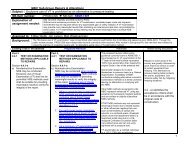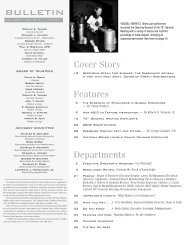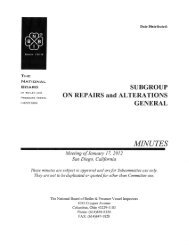bulletin - The National Board of Boiler and Pressure Vessel Inspectors
bulletin - The National Board of Boiler and Pressure Vessel Inspectors
bulletin - The National Board of Boiler and Pressure Vessel Inspectors
You also want an ePaper? Increase the reach of your titles
YUMPU automatically turns print PDFs into web optimized ePapers that Google loves.
Steam Car <strong>Boiler</strong> Explosions<br />
CCollecting data in a part-time, amateur manner on steam technology as it applies<br />
to automobiles for more than 40 years, I have found more than 55,000 steam cars<br />
were made <strong>and</strong> sold in the United States, most <strong>of</strong> them before 1905. I have also found<br />
remarkably few references to automotive boiler failures, <strong>and</strong> only ten mentions <strong>of</strong><br />
explosions with any detail. It is surprising that there were so few accidents!<br />
By Dave Nergaard<br />
Vice President, Steam Automobile Club <strong>of</strong> America<br />
Of the ten explosions, three occurred at a time when the very design <strong>of</strong> boilers was<br />
largely an experiment. Two more were not in cars, <strong>and</strong> one <strong>of</strong> these was a deliberate<br />
test to failure. That leaves five accidents to cars in private h<strong>and</strong>s, in the heyday <strong>of</strong><br />
steam cars, 1899-1908. Of these, three were caused by the dangerous feeding <strong>of</strong> a<br />
large amount <strong>of</strong> cold water to a low water reserve. Two involved boilers that may have<br />
been unsafe; proper inspection would have revealed the danger while the boilers were still cold. No explosions have<br />
occurred since 1910. <strong>The</strong> ten I am referencing are detailed below.<br />
1<br />
In 1834, a Scott Russell coach broke a wheel<br />
trying to negotiate a pile <strong>of</strong> rocks deliberately<br />
placed to block the road. <strong>The</strong> wheel failure caused the<br />
boiler to assume loads previously carried by the coach<br />
chassis <strong>and</strong> axles, which it was unable to do. <strong>The</strong> resulting<br />
explosion killed several people <strong>and</strong> ended the commercial<br />
viability <strong>of</strong> those coaches. However, the out-<strong>of</strong>-court<br />
settlement <strong>of</strong> the suit brought by Scott Russell against the<br />
turnpike company essentially absolved that boiler from fault.<br />
2<br />
At about the same time, a Walter Hancock<br />
coach exploded when the engine man tied<br />
down the safety valve <strong>and</strong> ran the declutched engine so<br />
the fan would force the fire! I don’t think I have to say<br />
much about this failure, <strong>and</strong> neither did the coroner’s<br />
court at the time.<br />
3<br />
A Goldsworthy Gurney coach had a boiler<br />
failure in June 1831, while on exhibit in<br />
Glasgow, injuring two children. It was reported that the<br />
coach was being operated without Mr. Gurney’s attendance<br />
or his permission.<br />
<strong>The</strong>se three incidents happened more than a decade before<br />
Bourdon invented the first practical pressure gage. <strong>The</strong><br />
only clue early engineers had to the pressure being used<br />
was the “feel” <strong>of</strong> the safety valve!<br />
4<br />
A blacksmith obtained a boiler rejected <strong>and</strong><br />
scrapped by the Stanley Company <strong>and</strong> attempted<br />
to use it without the usual wire wrapping used to<br />
strengthen Stanley boilers. According to the story, he<br />
destroyed the boiler, his shop, <strong>and</strong> himself. <strong>The</strong>reafter, the<br />
Stanley factory drove a spike through the side <strong>of</strong> any<br />
rejected boiler shell.<br />
5<br />
A member <strong>of</strong> the Stanley family tested the<br />
lightweight racing-type boilers that the Stanleys<br />
proposed to make the production boiler. A pit was dug<br />
behind the factory building, <strong>and</strong> a boiler with burner was<br />
NATIONAL BOARD BULLETIN/FALL 2003<br />
FEATURE<br />
17








